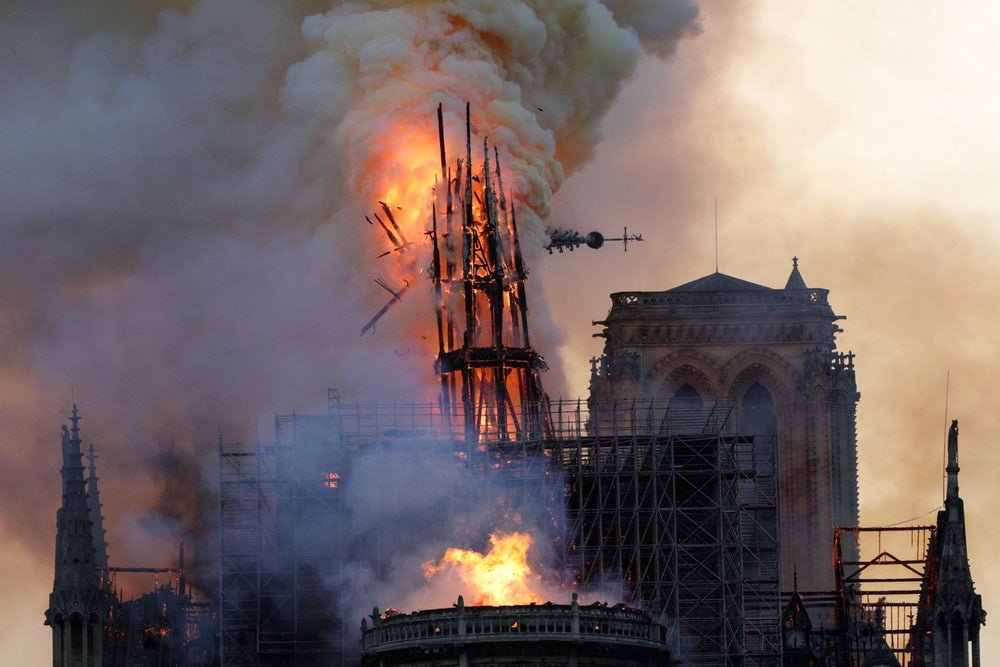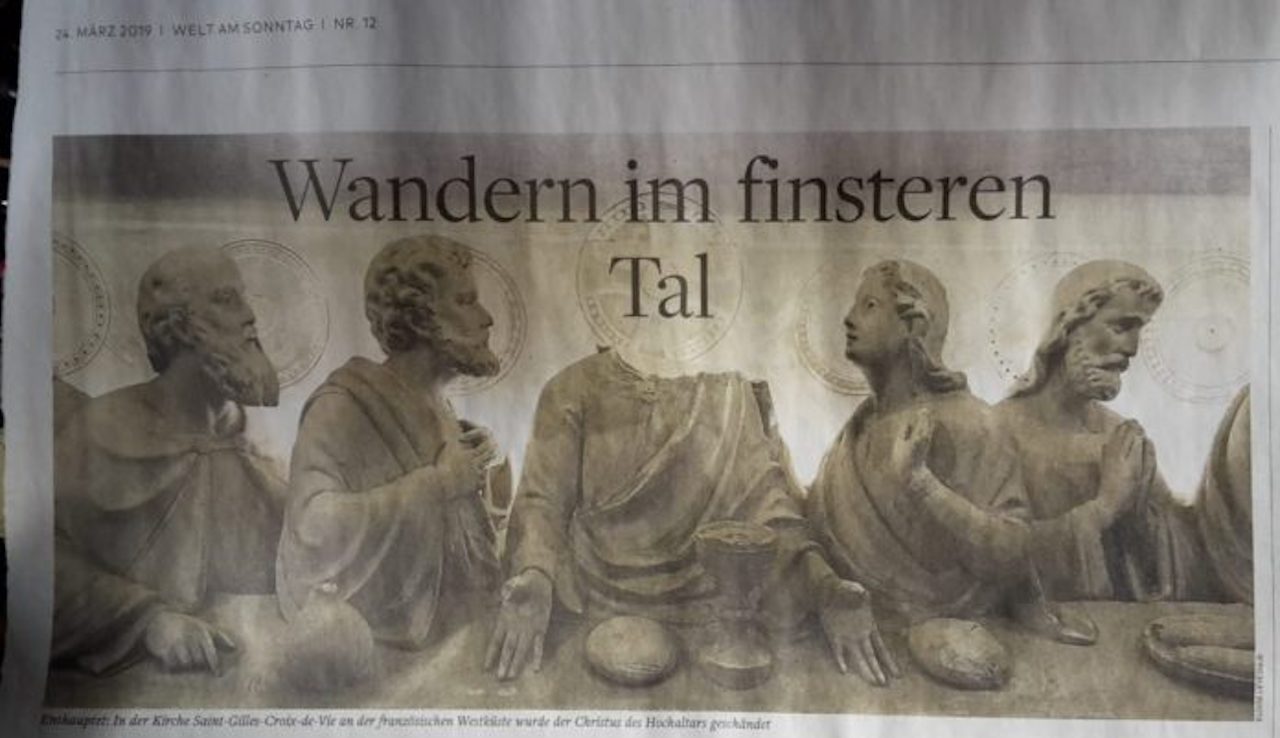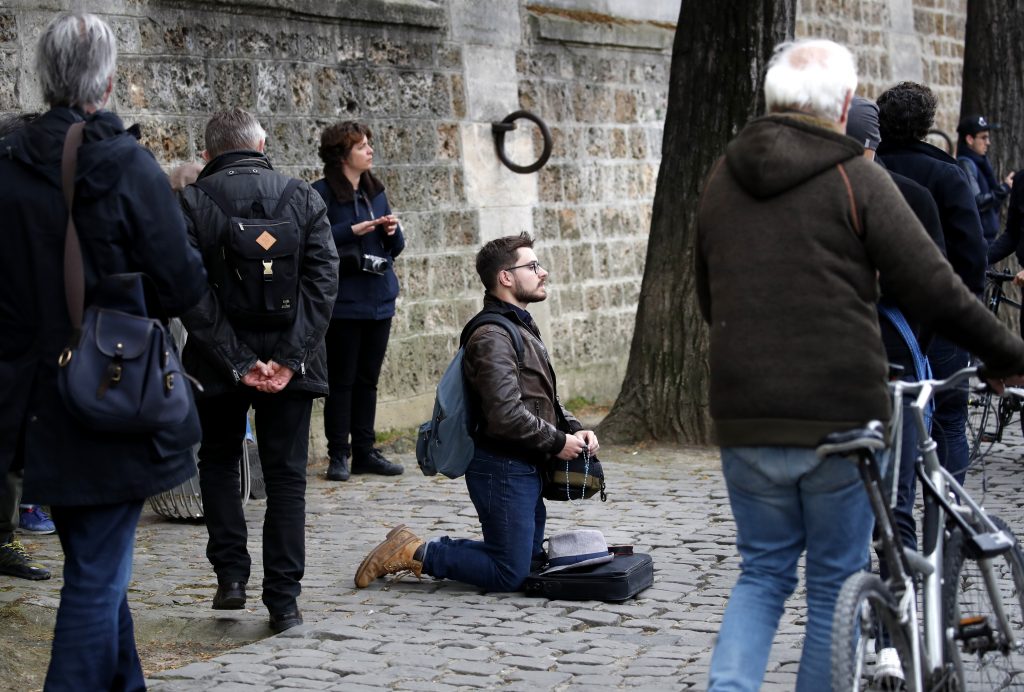My heart splintered watching Notre-Dame go up in flames. The disorder of my own responses—a jumble of dismay, anger, and foreboding—permits no tidy structure. What follows is a series of thoughts in no strict sequence. Bear with me.
• • • •
“Somebody did something” on 9/11. Taking a cue from Ilhan Omar, can we wonder if somebody did something to Notre-Dame? It is a rational conjecture. Watching the cathedral tower burn, it was impossible for the mind’s eye not to go directly to the burning towers of the World Trade Center.
More than reasonable, it is obligatory to connect those very dots that mainstream narratives are anxious to ignore. We watched the cathedral spire collapse and saw in those flames the resolve of political Islam’s incremental advance on French soil. No conspiracy theory was needed. We had only to know that Christians are subject to endless persecution in Muslim lands and, progressively, on their own soil as well. They are threatened by sporadic killings in their own markets, work places, and on their own streets.
Still, the great and the good scrambled to ban a priori any hint of intention in the flames. They refuse to heed the import of Tariq Ramadan’s tribute to Muslims as “the implacable ones.”
Arson? What Arson?
The moral consciences of our generation rushed to stifle any thought of Islamist pyromania. Before the fire had subsided, and several days before forensic teams could access the cooled rubble, authorities raced to wipe inconvenient parallels from popular imagination. They assured us that this conflagration—however stunning in force, symbolic in timing—was nothing more than an accident. Happenstance happens.
Experts who were nowhere near Notre-Dame ruled that, unquestionably, the fire was unintentional. Trust us. Typical of absentee certitude was Steward Kidd, a consultant in heritage protection and associate of the British Automatic Fire Sprinkler Association. He based his crackerjack assurance on the fact that, in his experience, 8 to 12 percent of all architectural heritage fires occurred when a contractor was on site. Kidd kept mum about the remaining 88 to 92 percent.
[Frank Hawkins, at American Thinker [2], notes a crucial fact: renovation work had not yet begun in the cathedral except for installing the scaffold. No heat-generating equipment was in use, suggesting that the source of fire was deliberate. Read the whole thing.]
• • • •
On April 14th, Raymond Ibrahim reported for Gatestone Institute [3]:
In France, two churches are desecrated every day on average. According to PI News [4], a German news site, 1,063 attacks on Christian churches or symbols (crucifixes, icons, statues) were registered in France in 2018. This represents a 17% increase compared to the previous year (2017), when 878 attacks were registered.
PI-News offers similar reports from Germany, adding: “Crosses are broken, altars smashed, Bibles set on fire, baptismal fonts overturned, and the church doors smeared with Islamic expressions like ‘Allahu Akbar.'” But strike that last identifying phrase. To name the aggressor is to be denounced as a bigot defaming a great religion and stigmatizing its faithful. To prove we are a tolerant society, we must blink at the intolerance of Islam toward ourselves and our symbols.
• • • •
Linger awhile where Victor Hugo pointed: “Humankind conceived nothing in the Middle Ages that it did not write in stone.” Theologians at work with chisels, rasps, and mallets, the great medieval cathedral builders translated stone into prayer. To Christians, Notre-Dame is a benediction in limestone. To the faithful of the Quran it is the kaffir’s idol.
“Islam is a French Religion”
The first French edition of Rodin’s Cathedrals of France (1914) was assembled from his private notes made over years of visits to French cathedrals, most of them in the French countryside. I read his eulogy to the Frenchness of them with a searing sense of loss:
To bring our people to the Cathedral is to bring them home, to their dwelling, to the citadel of their power. The country cannot perish so long as the Cathedrals endure. They are our Muses. They are our Mothers.
How long ago that sounds. Written before World War I, it echoes from another age. Rodin’s Cathedral now exists largely as a French Catholic Brigadoon that emerges from secular mists when a monument is needed for some ceremonial purpose. French cathedrals are muses still, but as goads to Islamic ambition, no longer as mothers. Listen to Tariq Ramadan, acclaimed propagandist for Islam, who gave the closing address to a conference of the Union of Islamic Organizations of France in Lille, in February 2016. Recognized globally as the luminary of Europe’s Islam, he struck a triumphal note:
France is now a Muslim culture. Islam is a French religion. You have the cultural ability to make French culture considered an Islamic culture among cultures.
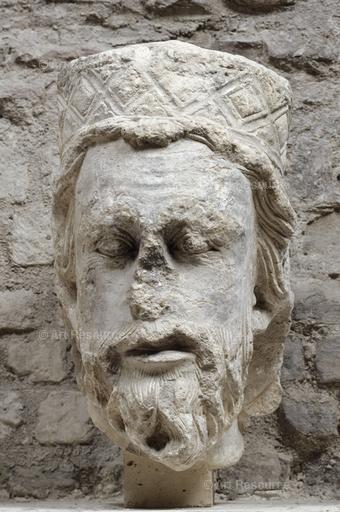 [6]
[6]
Catechisms in Stone
An old catechism from the diocese of Tréguier in Brittany asks the question: “What should you do upon entering a cathedral?” The answer reads: “Take holy water, adore the Blessed Sacrament, then walk all around the edifice and look at the stained glass windows.” Why? Because the anonymous masters of those medieval windows, too, contributed to the catechism. In the transfiguring chiaroscuro of the cathedral, men and women of the Middle Ages knew themselves to be enclosed with God.
In the words of Émile Mâle, “Christian thought was not expressed elsewhere so fully or so richly as in France. . . . Thirteenth century France was the fullest conscious expression of Christian thought.” He recognized in the cathedral not only the genius of all Christendom but also the genius of France:
The ideas which assumed substance in the French cathedrals are not the property of France alone; they were the common property of Christian Europe. Yet . . . France alone was capable of turning the cathedral into an image of the world, an abstract of history, a mirror of spiritual life. . . . There can be no doubt that in the domain of art, the greatest achievement of France was the cathedral.
Mâle emphasized Christian Europe, rightly so. For that very reason Notre-Dame is a magnet for Islamist malice. If this Holy Week blaze fails to sharpen our guard against the fire next time, then there is no point to rebuilding it. Better to leave it as is, a scorched portent of the future of France. And of a somnolent West.
• • • •
But, wait, you say—suppose this fire really was just a mishap?
Well, suppose it was. That in itself could be deemed happenstance of a different kind in a France that requires either the police or the army to guard cathedrals and basilicas. And, according to Pascal Bruckner, “parish priests are equipped with a device that enables them to launch a ‘terrorist attack alert.'” [An Imaginary Racism: Islamophobia and Guilt does not state when such devices were distributed. Bruckner simply notes it in passing after mention of the 2016 murder of Father Hamel in his church in Normandy.]
Whether accident or arson, the scarred cathedral serves as a parable in stone that presages the thrust of Islam’s offensive against Christian emblems and institutions. Let Notre-Dame stand as is in testimony to the fate of a culture too feeble to name the forces encroaching on it.
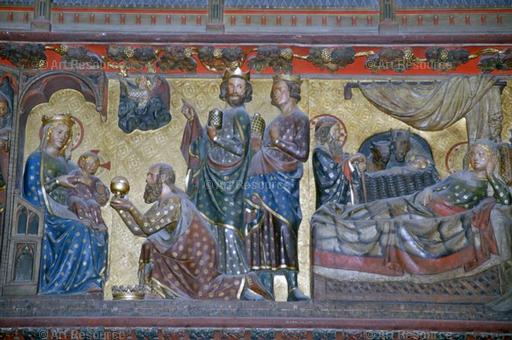 [7]
[7]
Who Now Reads Catechisms?
Dwindling numbers enter France’s cathedrals stirred by religious awe. Notre-Dame’s windows contribute mainly to guide books now. Sublimity shrinks to information, no longer a prompt to prayer but, rather, to stockpiling urbane experiences (established for all to see on Facebook and Instagram). How many persons come to stand where Paul Claudel, eighteen years old and filled with a sense of the ineffable, converted from disbelief to his ancestral faith? For most of the millions of who pass through the cathedral on tour, iPhones in hand, the cathedral is a tourist attraction, a starred item in a green Michelin.
In the phrasing of World Heritage mythology, Notre-Dame is a feature of “outstanding universal value.” UNESCO informs us it is “judged important to the collective interests of humanity.” Might those interests have something to do with the essence of Judeo-Christian civilization? Not necessarily. By design, a specified “global heritage” belongs to the global masses. All and sundry are shareholders in the designated asset. Like Chartres—another World Heritage Site—Notre-Dame dwindles to a day-tripper’s itinerary between Centre Pompidou in the morning, Le Bon Marché in the afternoon, and later a bouillabaise in Les Halles.
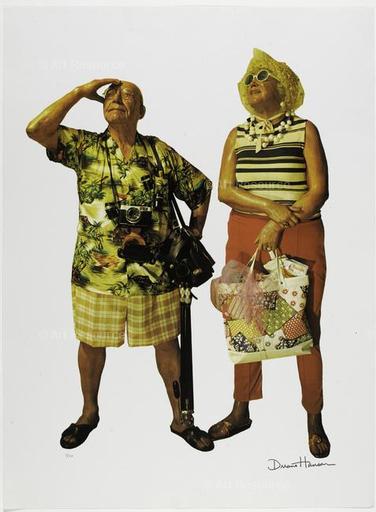 [8]
[8]
The UNESCO-ization of France’s cathedrals signals the vibrancy of global tourism, a consumer activity that celebrates the material stuff of heritage while it disregards the animating soul of it. Accumulating travel experiences is a hectic affair. From the get-go it tramples the ground of August Rodin’s deference: “The memory that one carries from the Cathedrals imposes silence, a fertile silence in which the soul knows its great well-being, the feast of thought.”
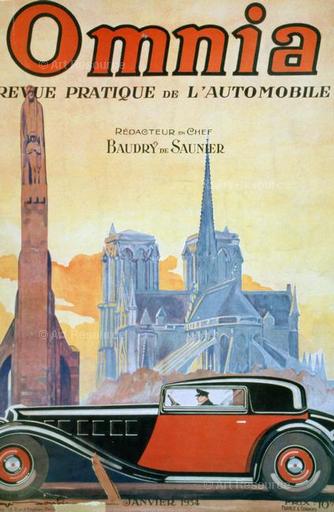 [9]
[9]
No Impure Thoughts, Please
Attacks on churches multiply in tandem with increased Muslim immigration. But it is deemed uncivil to call attention to the chasm between the progressive narrative and reality. Raymond Ibrahim put it sharply:
Hardly anyone writes and speaks about the increasing attacks on Christian symbols. There is an eloquent silence in both France and Germany about the scandal of the desecrations and the origin of the perpetrators…. Not a word, not even the slightest hint that could in anyway lead to the suspicion of migrants… It is not the perpetrators who are in danger of being ostracized, but those who dare to associate the desecration of Christian symbols with immigrant imports. They are accused of hatred, hate speech and racism.
As if to illustrate, Fox News hurried to protect audiences from contamination by unclean conjecture in the wake of the fire. Islamist enthusiasm for torching and wrecking is a forbidden topic on the networks. Neil Cavuto sped away from Bill O’Donohue when the Catholic League’s tribune had the bad manners to mention the current epidemic of violence against French churches. Similarly, Fox anchor Shep Smith cut short a call with French media analyst Philippe Karsenty for equal disrespect.
Karsenty, who lives in Paris and knows the ground, wanted to alert Fox’s audience against complacency:
Even if nobody died, it’s like a 9/11, it’s a French 9/11. It’s a big shock. This church was there for more than 850 years. Even the Nazis didn’t dare to destroy it. You need to know that for the past years, we’ve had churches desecrated each and every week in France, all over France. So, of course, you will hear the story of the politically correct — the political correctness which will tell you it’s probably an accident.
That was too much for Smith. Very likely remembering what happened to some people in the Charlie Hebdo office in 2015, Smith brandished his righteous-infidel creds. He delivered a smug scolding that ended:
. . . conspiracy theories about anything are worthless and in many cases counter productive and injurious to society. And those who entertain them are not acting in the best interests of the people of this planet.
The people of this planet. A helluva phrase. Karsenty sinned by acting in the best interests of his fellow Frenchmen and, by extension, listening Americans. Ideologically driven, Smith’s wording annihilates Notre-Dame as the consummate expression of a particular people, one whose techniques developed out of a distinct cultural sensibility: an innate sense of national identity interwoven with a Christian vision.
Because Notre-Dame symbolizes not only France or Catholicism but Western civilization, the sight of it burning sears our own souls. This fire is all the more piercing for having accented the fragility of the West under siege by a reinvigorated Islam and a resentful Third World primed to colonize Westerners in their own countries. Meanwhile, our opinion makers encourage us to be protective of an alien culture that would gladly destroy us.
Let’s Pretend
The Organizations of Islamic Cooperation (OIC), meeting in Istanbul in 2013, sought to make criticism of Islam an international crime subject to penalty. In particular, the OIC sought to dissolve association between Islam and violence. What the OIC did not accomplish de jure, has been achieved de facto by feckless blue-sky Westerners in solidarity with all cultures, all peoples but their own.
One hardly has to be paranoid to suspect that political Islam is winning. And it is doing so in a way familiar to anyone who remembers that, not so long ago, it was verboten for Soviet citizens to criticize the USSR. Such criticism gave an aid and comfort to the enemy, it was said. Criticism played into the hands of the enemy. It must be stifled.
Just so, our pundit class determines that rational association of Islam with violence is, in Smith’s words, “counter productive and injurious to society.” The Better Sort insists that telling the truth plays into the hands of aggrieved fanatics who are driven to act out their animus. Better to play “let’s pretend” and keep laying planks over rivers of blood.
To Rebuild Or Not
We are left with a certain unease about the character of restorations made under the eye of the U.N. and in service to the planet’s multitudes rather than in celebration of the distinct religious and cultural identity of the people who built it. I cannot shake the thought that to rebuild Notre-Dame in the current climate of self-censorship is to create a monument to denial.
On Good Friday, New York’s Cardinal Dolan repeated the reigning position. He cheered the news that Notre-Dame could be rebuilt, then repeated the permissible verdict, one freighted with unskeptical relief: “The other good news, we have to admit this was an accident. I think all of us at the beginning thought, oh, no, this is a terrorist act…thank God that didn’t happen.”
We really do not know that it did not happen. Some forty-seven attacks on French churches and religious sites in February alone give pause to Cardinal Dolan’s palliative. Easter Sunday’s mass murder in Sri Lanka casts a lurid rearward light onto Notre-Dame. Our network sages are quick to take questionable comfort at face value. To rebuild while we remain allergic to even asking reasonable questions or exploring legitimate surmises, is imprudent. We risk turning what was once an eight-centuries-old cathedral into a Potemkin Village for dhimmis.
• • • •
Coventry’s 14th century St. Michael’s Church, known as Coventry Cathedral, was demolished in the Blitz by Germany’s Luftwaffe in 1940. The ruins of the old St. Michael’s are still there, mutilated companion to the new Coventry Cathedral, consecrated in 1962. Perhaps there is a lesson there for us.
“It Is Margaret You Mourn For”
It was impossible not to be moved by the photographs of people, many of them young, kneeling in the streets around Notre-Dame as it burned. Friends saw in those images signs of hope, inklings of resurrection. I did not. What came immediately to mind were those bittersweet lines from Gerard Manley Hopkins’ “Spring and Fall: to a Young Child”:
Márgarét, are you gríeving / Over Goldengrove unleaving? . . . It is the blight man was born for, / It is Margaret you mourn for.
Christianity is unleaving in the West. Civilizations, too, have their seasons.
